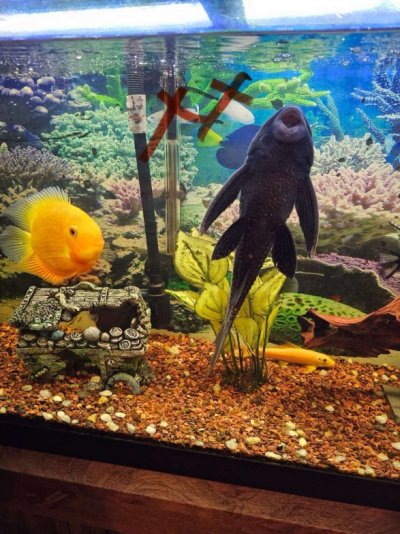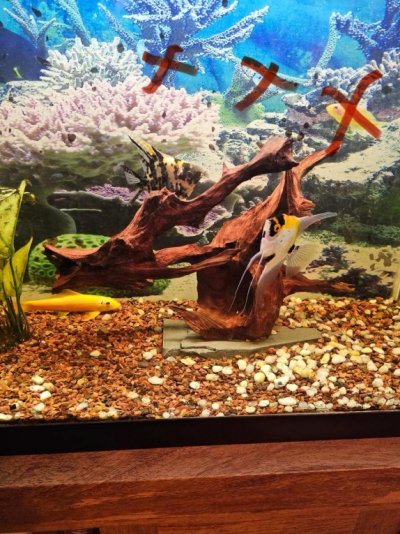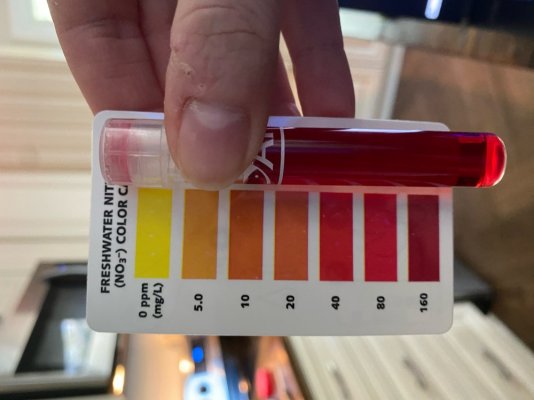Bent Needle
Aquarium Advice Regular
So, I'll try to make this as short as possible, but that's hard for me. 
TL;DR - I adopted my friend's husband's 55 gallon tank that he no longer wanted in their (admittedly tiny) house, and now I think there may be big problems with the stocking.
From what my friend said it sounded very well managed and happy and like there would only be the usual challenges of acclimating fish to new water and of course the stress of transport. It looked lovely and had been setup with these five fish in it for about two and a half years. 5 medium size fish in a 55 gallon sounded decent to me, especially with a canister filter and considering they've been happy and healthy for that long. Today they delivered the whole setup to my house. The tank is clean except for some algae (nothing over the top, and to me means a decent bacterial colony), the fish seem pretty calm and chill after having a couple of hours in a dim room. However...I just put them all and the equipment into AqAdvisor (what I've used to make stocking and equipment decisions in the past), and I'm worried. It says that the tank is overstocked (107%), and needs more filtration (at 77%). Fish are as follows:
2 adult angelfish
1 Redhead Severum, ~5-6" long
1 Chinese algae eater, ~4-5" long
1 common pleco, ~12" long
AQAdvisor also warns that the severum and algae eater are not done growing at these sizes and will cause significant problems as they get bigger (the Severum for filtration, the algae eater because of aggression). I was a little shocked at the size of the common pleco - which I knew could get huge but I'd never seen one this big except in a store - it managed to get the entire room wet when we tried to get it out of the bucket without touching the spiny back!
Please give me opinions. Is AQAdvisor just super conservative and these fish will be fine, since they've already been fine so long? Or do I need to plan to downsize the residents/increase filtration/something else?
Pics attached with the fish on the (saltwater) background crossed out.
TL;DR - I adopted my friend's husband's 55 gallon tank that he no longer wanted in their (admittedly tiny) house, and now I think there may be big problems with the stocking.
From what my friend said it sounded very well managed and happy and like there would only be the usual challenges of acclimating fish to new water and of course the stress of transport. It looked lovely and had been setup with these five fish in it for about two and a half years. 5 medium size fish in a 55 gallon sounded decent to me, especially with a canister filter and considering they've been happy and healthy for that long. Today they delivered the whole setup to my house. The tank is clean except for some algae (nothing over the top, and to me means a decent bacterial colony), the fish seem pretty calm and chill after having a couple of hours in a dim room. However...I just put them all and the equipment into AqAdvisor (what I've used to make stocking and equipment decisions in the past), and I'm worried. It says that the tank is overstocked (107%), and needs more filtration (at 77%). Fish are as follows:
2 adult angelfish
1 Redhead Severum, ~5-6" long
1 Chinese algae eater, ~4-5" long
1 common pleco, ~12" long
AQAdvisor also warns that the severum and algae eater are not done growing at these sizes and will cause significant problems as they get bigger (the Severum for filtration, the algae eater because of aggression). I was a little shocked at the size of the common pleco - which I knew could get huge but I'd never seen one this big except in a store - it managed to get the entire room wet when we tried to get it out of the bucket without touching the spiny back!
Please give me opinions. Is AQAdvisor just super conservative and these fish will be fine, since they've already been fine so long? Or do I need to plan to downsize the residents/increase filtration/something else?
Pics attached with the fish on the (saltwater) background crossed out.




 This isn't my first time using a kit, I followed the instructions EXACTLY and when I got that I immediately repeated it because I thought surely not...but no, it is the deepest darkest red I have EVER seen on a test (see pic).
This isn't my first time using a kit, I followed the instructions EXACTLY and when I got that I immediately repeated it because I thought surely not...but no, it is the deepest darkest red I have EVER seen on a test (see pic).